I took Amtrak's seasonal ski train in Colorado during opening weekend. Here are the 6 best and 4 worst parts about the ride.
Monica Humphries

- I took Amtrak's Winter Park Express train from Denver, Colorado, to the Winter Park ski resort.
- I thought the two-hour ride had pros and cons for skiers and snowboarders who want to skip driving.
Earlier this month, I ditched my car and boarded Amtrak's Winter Park Express train to take me to the ski slopes.
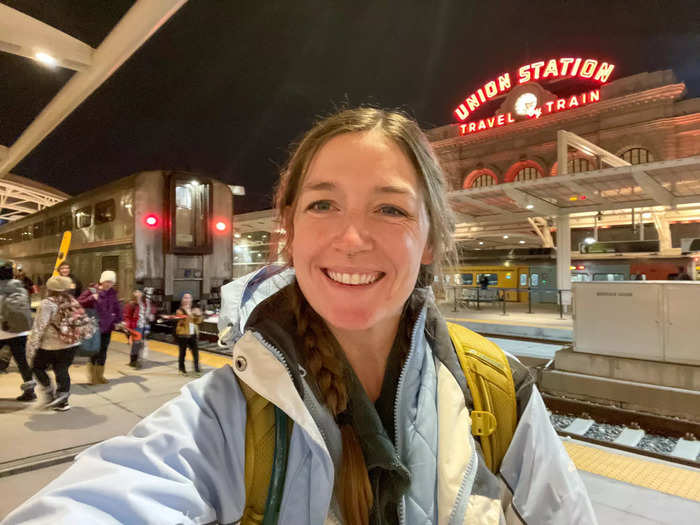
As I prepared for a weekend of skiing, I wasn't happy to wake up at 5:45 a.m. to get to the slopes. But I was thrilled I didn't have to drive.
That's because I was riding Amtrak's Winter Park Express train. The direct, two-hour train ride picks passengers up in Denver, Colorado, at 7 a.m. and drops them off around 9 a.m. at Winter Park Resort, a ski resort with 3,081 acres of terrain.
In the afternoon, the train departs Winter Park at 4:30 p.m., which is a half an hour after the lifts close, and arrives in Denver at 6:40 p.m.
The seasonal train operates from mid-January to late March and has a 540-passenger capacity, according to Westword. It makes one round-trip ride a day and runs on Fridays, Saturdays, and Sundays.
I boarded the train during its opening weekend this winter. As I climbed into the double-decker Amtrak Superliner train, I wondered whether or not I'd be able to justify the roundtrip $118 ticket, whether the seats would be comfy enough for two hours, and if the mountain views would be as stunning as Amtrak promised.
Here's a closer look at the best and worst parts of my train ride, and why I'm ultimately glad I did it.
I appreciated that I got to skip highway traffic and enjoy striking views instead.
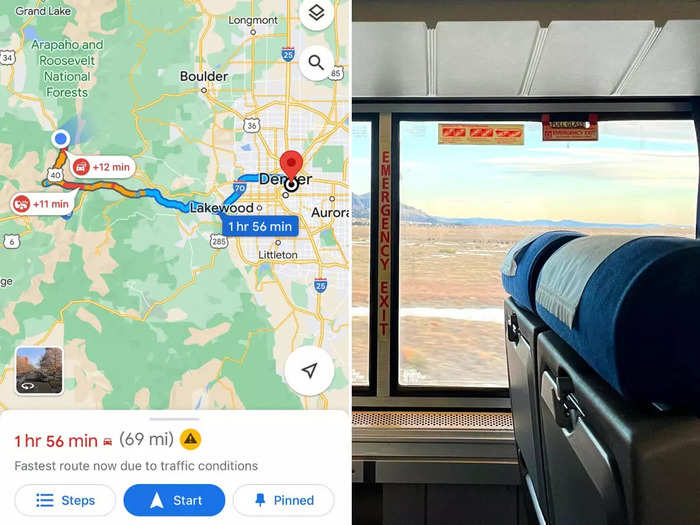
As a Denver resident, driving on a crowded highway as snow pours down is my nightmare.
So, trading a long drive for the stress-free train ride was easily my favorite perk of the Winter Park Express.
Instead of worrying if the cars in front of me had snow tires and were equipped to drive on ice-covered-asphalt, I was able to appreciate the surrounding mountain views, snack on Skittles, and relax in a seat that I found to be comfier than any car.
I was also able to avoid the traffic on Colorado's I-70 highway. As our train rode the rails, Google Maps showed traffic delays heading to Winter Park on Saturday and again heading home from Winter Park on Sunday.
Plus, the views, including a herd of antelope, mountain ranges, and snow-topped trees, were ones I would have missed if I had my eyes glued on the road.
The Winter Park train station is located at the edge of the mountain, which meant I was on the slopes just minutes after arriving.
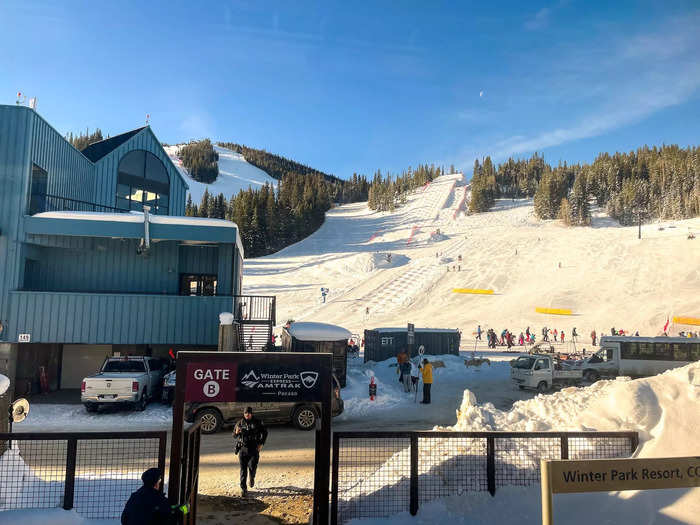
When the Winter Park Resort came into view and the train pulled to a stop, I couldn't believe how close I was to the slopes.
From my train window, I could see three lifts within walking distance of the train.
I hopped out and realized that the resort's rental shop, restaurants, bars, and downtown area were all less than a five-minute walk away.
If I had been driving, I likely would've parked in a free lot and shuttled to the slopes in the morning and at the end of the day, which would've been a timely hassle. My friends, for instance, told me they waited about 30 minutes to board a shuttle back to their car at the end of the day.
I was surprised to see that passengers on the Winter Park Express were able to soak in both the sunrise and sunset, right from the train.
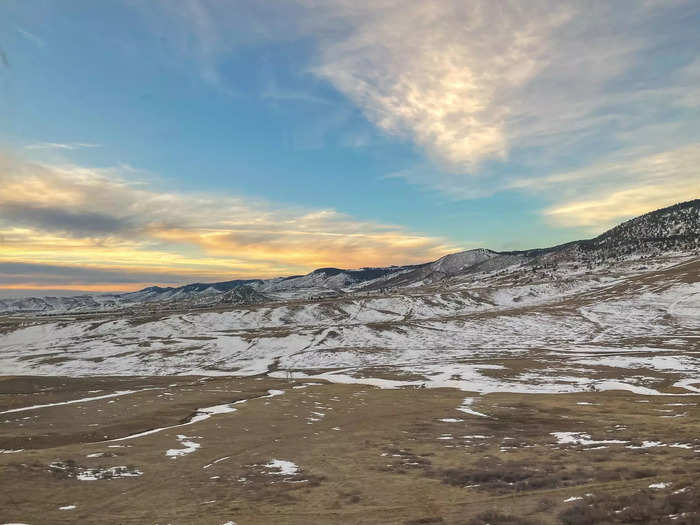
While I wasn't thrilled to wake up early, it paid off once we started moving.
Since the train leaves from Denver's Union Station at 7 a.m., and the sun starts rising about 15 minutes later, I watched in awe as the skies and clouds blossomed in pink and blue pastel colors.
It was a surprise I didn't anticipate. And I quickly realized that I'd get to enjoy the sunset on the ride back home, too. Since the train leaves at 4:30 p.m., I'd have just enough time to get settled in my seat to enjoy a 5 p.m. sunset.
While the mountain views alone were stunning, add in a beautiful show put on by the sky, and I was thrilled that the train's schedule aligned perfectly with the sun's twice-daily performance.
I think one of the best parts of the train's schedule is that it allows passengers to enjoy an entire day on the slopes.

If I'm taking a train, I don't expect a train schedule designed around my activities.
But that was not the case for the Winter Park Express. Since most of its passengers take it specifically to ski or snowboard, Amtrak scheduled the train around the resort's hours.
The train drops passengers off minutes after the Winter Park lifts open, and the same train departs half an hour after the lifts close. This means skiers and snowboarders get an entire day on the mountain without having to consider leaving early.
If I hadn't taken the train, I likely would've cut my day short to try and avoid rush hour and traffic on the drive back home.
The seats are nicer than any plane or other train I've taken before.
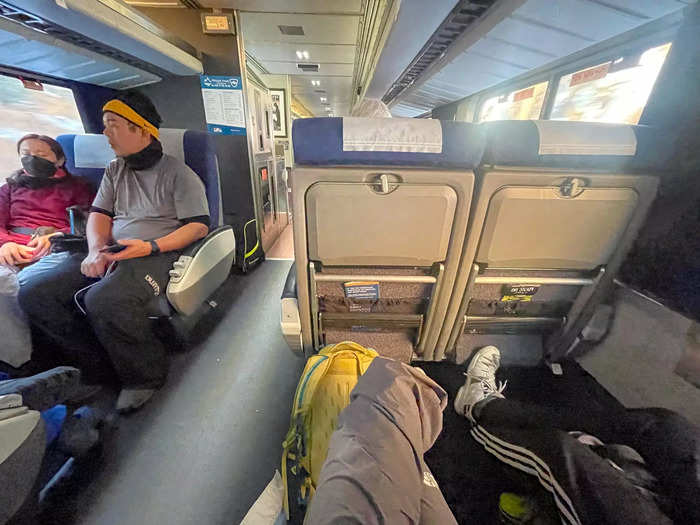
I typically expect cramped quarters and uncomfortable seats when I'm traveling by plane or train, based on past experiences.
But the seats on the Winter Park Express challenged those expectations.
While there's only coach class on the train, I found the seats to be much wider than the other trains I've taken. They were also cushioned and reclined.
Plus, the train cars lacked a middle seat, which meant no one had to be squished between two people.
And in front of me, I had ample legroom. At 5 feet and 8 inches, I could stretch my legs all the way out while also having enough room to keep my backpack stowed away near the seat in front of me.
While I planned to rent equipment, I was impressed by the free storage onboard for skis and snowboards.
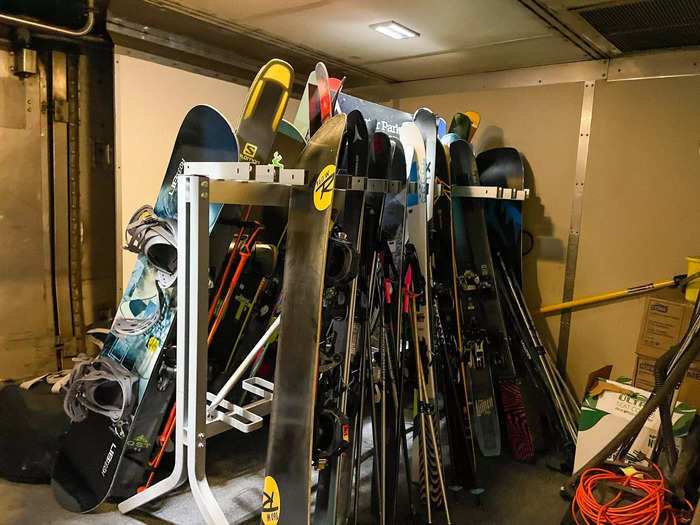
Traveling with oversized items can be a hassle. In my experience, planes and trains often charge extra to check skis and snowboards. But on the Amtrak Winter Park Express train, you're encouraged to pack and bring your gear at no extra charge.
Each passenger can bring two carry-on bags (skis or snowboards count as carry-on baggage), as well as two personal items for free, according to Amtrak. Amtrak's baggage policy states that each additional bag costs $20, with a limit of two extra items.
The train also designed its storage compartment for skis and snowboards with ski racks positioned inside the storage rooms onboard the train.
And from what I saw, the entire luggage process was efficient. Volunteers helped passengers place their gear on the designated racks, and there never was a long line to hand over or receive belongings.
While there are many benefits to taking the Amtrak Winter Park Express train to the slopes, it's likely to be more expensive than driving, if you own a car.
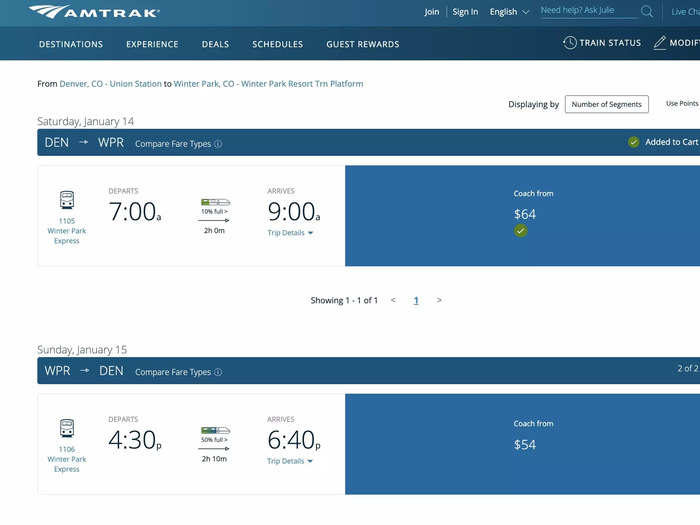
While you'll be able to skip bumper-to-bumper traffic by taking the Winter Park Express, I think it's a hard price to justify if you have a car in Colorado.
My round-trip ticket cost $118. Meanwhile, gas to get to Winter Park would've been a fraction of the cost. According to the US Department of Energy, gas to and from Winter Park would've cost less than $30, and I could've split that cost with friends if we carpooled. And since Winter Park has free parking lots and shuttles, I wouldn't have to factor in extra budget for parking, either.
I spoke to passengers on the train who shared similar sentiments about the price. Most said they were celebrating and used that to justify the cost of the trip. There was a bachelorette party onboard, and other groups told me they were taking the train as part of a birthday trip and an anniversary present.
For out-of-state visitors without a car, it might be worth the price, though. My seatmate, who was visiting from Wisconsin and lacked a car, said that his train ticket was cheaper than the price of a rental car.
I researched on Hertz, for example, and found that the cost of a car for one weekend day costs between $80 and $150 before taxes. Plus, the train means visiting tourists can stay off icy and unfamiliar roads.
While I got to watch the sunset and sunrise, the train's once-a-day schedule meant I sacrificed flexibility with my plans.
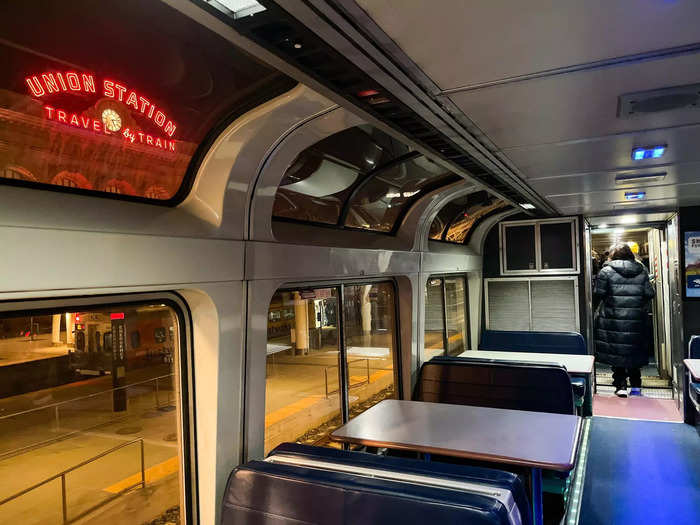
The train makes one round-trip route on Fridays, Saturdays, and Sundays. So if you miss the departing 7 a.m. train, you'll have to find another way to the slopes.
The schedule also meant that I had to plan my entire day around the train and lost some autonomy in making spontaneous decisions.
For example, when friends wanted to hit aprés or happy hour after the lifts closed, I wasn't able to join since I had a train to catch.
Other travelers may have the opposite problem. If you got tired and wanted to call it quits early, you couldn't since the train doesn't leave until 4:30 p.m.
I also thought that the train's schedule made it challenging to take a ski or snowboard lesson on just a day trip.

Last winter was my first time on a snowboard. This year, I decided I wanted to continue snowboarding and also give skiing a shot.
So I decided to sign up for Winter Park's ski school. But after looking at the times, I realized that a ski lesson wouldn't be possible if I was spending just one day at Winter Park.
The resort's morning classes start at 9:15 a.m. Between potential train delays and the time it would take to rent ski gear, I likely wouldn't have made it to the lesson on time.
I faced a similar issue with the resort's afternoon classes, which end at 4 p.m. I feared that the class would run late or I wouldn't have enough time to drop off my rental gear, and worried that I'd miss the train back to Denver.
Ultimately, I decided I needed to extend my trip and spend a night in Winter Park in order to take a ski lesson. It was the only way I could guarantee I'd be on time for both a lesson and the train. This added to my overall cost too, which already was more expensive than if I just drove for the day.
I was disappointed to find that there's limited space in the lounge car.
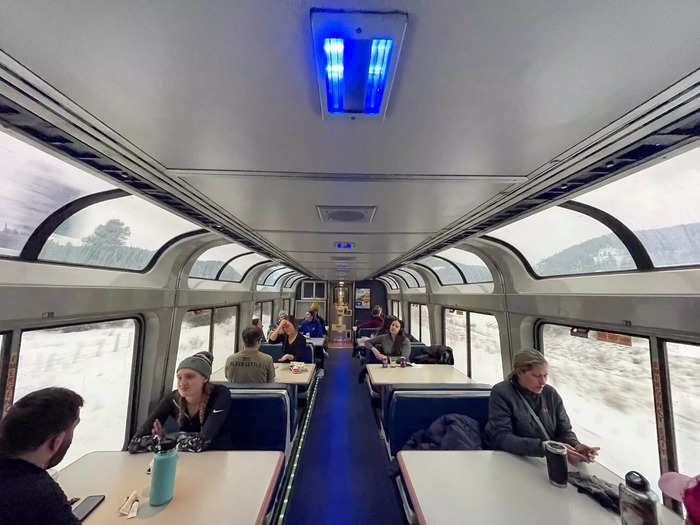
One of the train's features I was most excited to check out was the lounge car.
The dedicated lounge car is one of the train's five cars. The bottom level houses the train's café, which serves alcoholic and non-alcoholic drinks and prepacked snacks.
But the top area was what I was excited to explore. Above the café was a lounge with glass-domed windows and first-come, first-served seating. I've experienced the wonder of massive, curved windows before on a Rocky Mountaineer train ride from Denver to Moab, Utah, and I knew they live up to the hype.
But when I entered the lounge about 45 minutes into the two-hour ride on the way to Winter Park, I realized that I wasn't going to be spending much time in the lounge. Every seat was taken, and it didn't seem like anyone was planning on leaving anytime soon.
I wished that there was a way for more people to enjoy the seats, but it seemed like the only way to guarantee I'd enjoy the glass-dome views was if I arrived early to the train platform for the ride home.
And that's what I did. I got to the train 40 minutes early for my return trip, which cut into my skiing time. But I was ultimately happy with my decision — the entire lounge was full just seven minutes after the train doors opened, and the views paid off. I marveled as the sun set behind the Rocky Mountains and spotted Denver's skyline twinkling in the distance.
I thought the views from the lounge window were much better than from my coach seat, where I had to lean over my seatmate to see views and photos.
On my dream train, every car would have glass-dome windows so every passenger could soak in the mountain views in this way.
While I can't afford to take the train every weekend I want to ski, it was a fun splurge with benefits that outweighed any disadvantages.

The Winter Park Express got me to the slopes stress-free.
While it was a bit of a splurge considering how much cheaper it would've been to drive, I thought it was ultimately worth paying a bit more for the experience, convenience, and views.
But like some of my fellow passengers, I'll be reserving this ride for special occasions only.
Popular Right Now
Popular Keywords
Advertisement